| ||
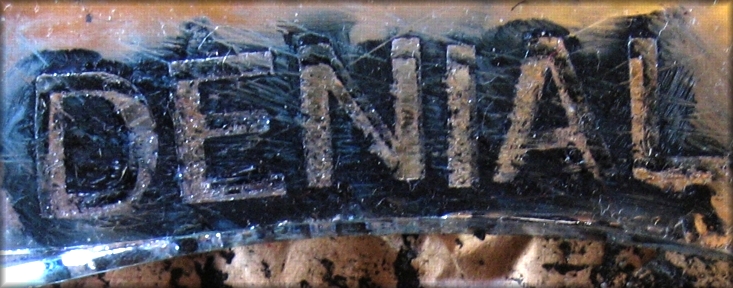 | ||
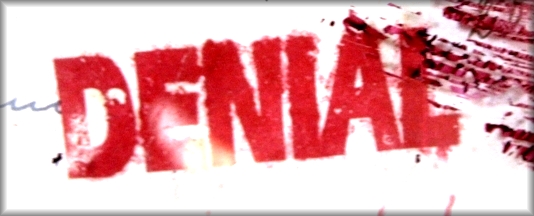 | ||
 | ||
I was asked to create a work of art for an exhibition at the University of Colorado titled: 'Art from A to Z.' Each invited artist was given a letter and had to use it to express an important word beginning with that letter. I was assigned "D" and chose the word "Denial." This work examines how Germans before, during and after the Holocaust, Jews and Americans alike all operated in different states of denial. Lessons from mistakes made then are relevant today. A similar and silent population in danger of destroying our world, simply looks the other way instead of facing tough realities and denies minorities access to equal rights. Denial, inaction and indifference by the many masses allows the few in power to commit reckless and heinous acts to our environment and people today just as they were allowed to do back then on a different scale. It was a time still in the memory of people alive today and newer generations are not unlike them. Images, text from the piece, and comments follow below: | ||
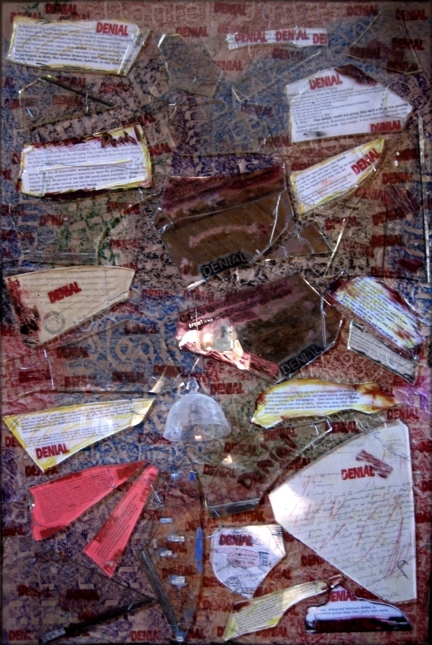 | ||||
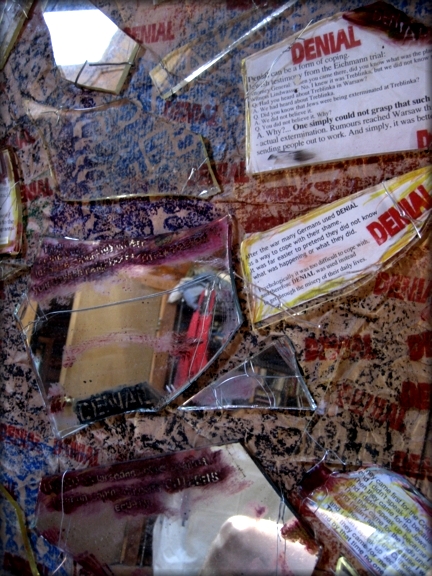 | ||||
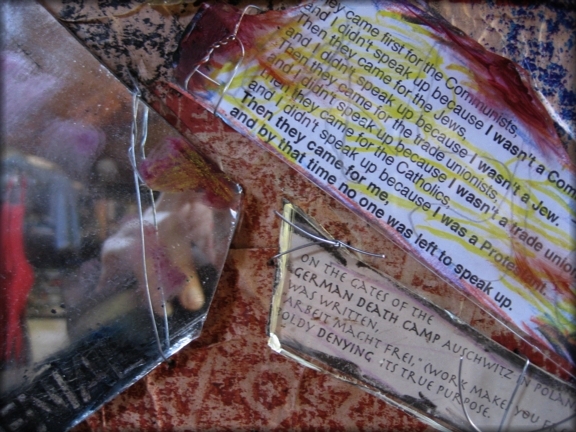 | ||
Text: In March of 1933, a majority of German citizens did not vote for Hitler. The Nazis grew bolder and more voracious as they continued slicing away at civil society. Many Germans (including some of Hitler's original corporate backers) were convinced Nazism would collapse as it became more and more extreme; others chose denial. It was easier to look the other way. How could you look the other way when your Jewish neighbors disappeared? “Conspiracies against democracy don't need lots of people to participate in them, they need millions, however, to stay silent to ensure their success.”
"It also gives us a very special, secret pleasure to see how unaware the people around us are of what is really happening to them." - Adolf Hitler
Denial can be a form of coping. Jewish testimony from the Eichmann trial: Attorney General: When you came there, did you know what was the place you had arrived at? Witness Lindwasser: No. I knew it was Treblinka, but we did not know the purpose. Q. Had you heard about Treblinka in Warsaw? A. We had heard about Treblinka. Q. Did you know that Jews were being exterminated at Treblinka? A. We did not believe it. Q. You did not believe it. Why? A. Why?... One simply could not grasp that such a thing was possible - actual extermination. Rumors reached Warsaw that the Germans were sending people out to work. And simply, it was better to cling to this idea.
REPORT TO THE SECRETARY ON THE ACQUIESCENCE OF THIS GOVERNMENT IN THE MURDER OF THE JEWS Randolf E. Paul, general counsel to the Treasury Department. Jan. 13, 1944 "There was no effort of any kind made by the United States Government to save from death many of the refugees who could have been saved during the time that transportation lines were available and there was no obstacle to their admission to the United States... During WWII, the US Government actually actively prevented the rescue of Jews by placing administrative restrictions upon the granting of visas to the United States. 90 percent of the 580.000 quota places available to immigrants from countries under German and Italian control were never filled. " Entry Denied. Requests were answered with Denial.
In 1939, The ship SS St. Louis contained approximately 925 Jewish refugees attempting to escape Nazi Germany , all passengers had legitimate landing certificates. The St. Louis requested entry into the United States, but was DENIED. Nine-hundred people could have been saved had America not DENIED entry to the refugees aboard the ship. These refugees later perished. On September 11, 1940, the Jewish refugee ship Quanza stopped to refuel at Norfolk, Virginia after having been DENIED entry into the United States. The frantic and futile search for a safe haven from Nazi persecution led one German Jew to dive overboard in a desperate swim for shore. He was captured by an Army guard of the US and returned to the ship.
They came first for the Communists, and I didn't speak up because I wasn't a Communist. Then they came for the Jews, and I didn't speak up because I wasn't a Jew. Then they came for the trade unionists, and I didn't speak up because I wasn't a trade unionist. Then they came for the Catholics, and I didn't speak up because I was a Protestant. Then they came for me, and by that time no one was left to speak up.
On the gates of the German Death Camp Auschwitz in Poland was written, "Arbeit macht frei," (Work makes you free) boldy denying its true purpose.
Jews desperately trying to get out of Germany wrote letters to any American with the same last name hoping among them to find a sponsor for immigration. One return letter of DENIAL is incorporated into this artwork. American Jews often chose DENIAL and elected not to believe the the severity of the Holocaust.
After the war many Germans used DENIAL as a way to cope with their shame. It was far easier to pretend they did not know what was happening or what they did. Psychologically it was too difficult to cope with, and therefore DENIAL was used instead to get through the misery of their daily lives.
The background is made from rubbings taken from the ruins of the Jewish Cemetery in Waldbreitbach. Jews who had been invited into the community had their homes and businesses sacked by neighbors and friends on the infamous Kristallnacht. They were forced to sell possessions at a fraction of their worth and were exiled from the town. Many of those properties are still owned by the families that took them then.
Today, widespread Holocaust DENIAL by extremist groups helps them justify their mania.
In 1992, Colorado voted for Amendment 2, denying rights to undesirable citizens. It became known as “THE HATE STATE.”In 2006, Colorado voted against Referendum i, denying equal rights to undesirables. Polls indicated it would pass but in thevoting both, true feelings were expressed. In 2008 voters in California, Florida and Arizona voted to deny gays equal rights. The California vote was in favor of Proposition 8, unique and terrifying in that it actually took away rights already granted.
Nazis succeeded by systematically one by one taking basic rights away from Jews. Tim Miller calculated that today lesbian and gay couples are DENIED the same 1,047 legal rights and protections obtained automatically by heterosexuals who marry. Gay and lesbian couples can be DENIED admittance into an emergency ward to see their partners because they are not legally the next of kin. They don't have the right to share tax returns, pensions, or government benefits like Social Security. They can't share parental custody, join property, health insurance, or automatic inheritance rights. They can't make medical decisions if their partner becomes disabled. Even their wills and Powers of Attorney can be set aside by judges who refuse to recognize their long-term relationships. Bi-national lesbian and gay couples are DENIED immigration rights reserved only for heterosexual couples and are forced to break up or leave the country to maintain the relationship. | ||
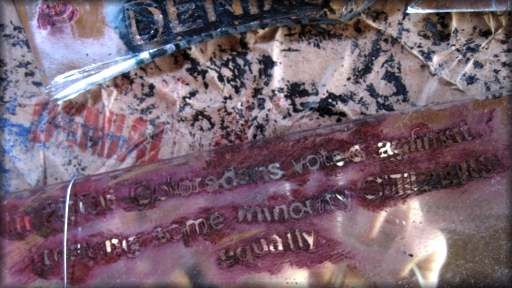 | ||||
A mirror asks the viewer directly, "How could you look the other way when your Jewish neighbors disappeared?" Today, most believe that they would not look away if it had been them, but the next mirror points out that "In 2006, Coloradans voted against treating some minority CITIZENS equally." It is a shocking reminder that today's Coloradans reflected in mirror have a certain like mindedness to Germans of the 1930s who believed or at least tolerated the notion that only particular citizens deserved rights and protection. Thus, the majority of Colorado voters may be in denial believing that they would have acted differently had they been in Germany in the 1930s. | ||||
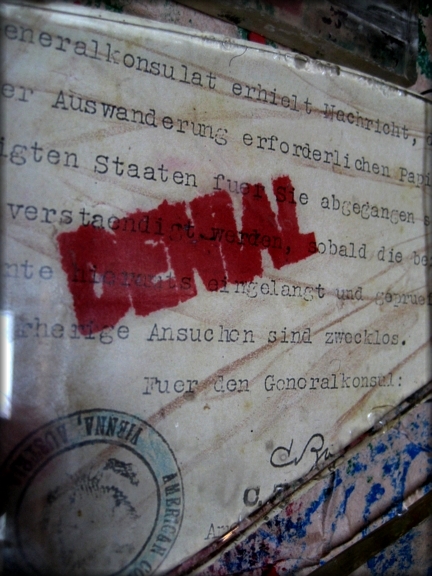 | 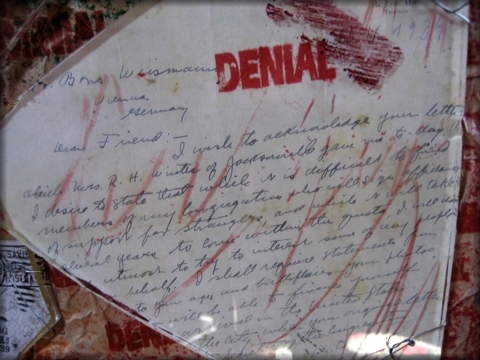 | |||||
An actual DENIAL letter from the American Consulate in Austria answering a Jewish request to immigrate to America. The American Government under the direction of Breckenridge Long denied Jews immigration and let approved quotas remain unfilled. A 1939 letter from an American Rabbi delaying help to sponsor immigration for a European Jew for several years. He, like many others, could not allow himself to believe that the horrors of Holocaust were actually happening. Denial was easier. | ||||||
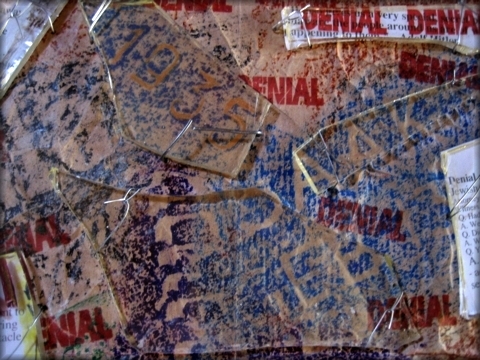 | ||||
Vintage broken window glass, mirrors, plates and crystal evoke Kristallnacht, sharp twisted wire evokes the Ghetto enclosures and German death camps. | ||||
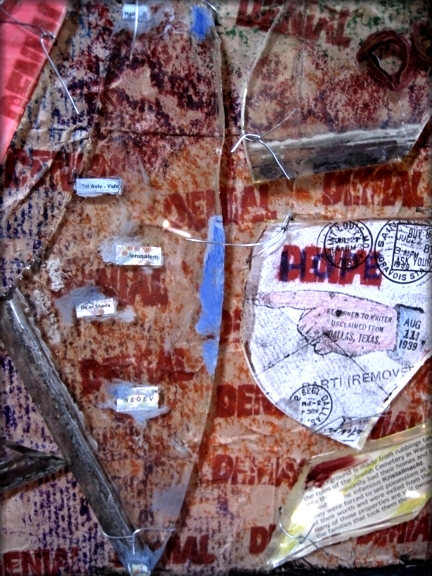 | ||||||
Pink paper is used for discussion of gay rights. A returned envelope is a dashed hope to find a sponsor for immigration. The hand points to a piece of glass that resembles the Israeli State which finally came about after the Holocaust and decades of British cruel mismanagement. | ||||||
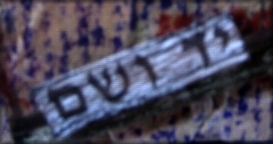 | ||||||
It is not my intent to lessen the magnitude of the Holocaust by comparing its pre-murderous beginnings to some disturbing trends in American society today. There are frightening parallels that cannot be denied and therefore it is my intent that by illuminating those similarities, lessons from Europe of the 1930's will not be forgotten. Hitler took over power in January 30, 1933 and soon after on April 7, 1933, the Civil Service Law was enacted which denied Jews the ability to hold public service jobs. These included teachers and lawyers. All Jews in academic positions lost their jobs only because they were Jewish. They could not accept the failure of their non-Jewish co-faculty members to protest. Most gay people in the USA live in fear of being fired simply because they are gay. They resent the fact that they live among a population in which the majority of their own neighbors accepts if not supports that situation. It was not an anomaly of German culture that allowed the unique and incomparable events to develop. The German people of the 1930's are wholly responsible just as our generation is responsible for the intolerance, loss of civil liberties, destruction and even genocide we allow to happen domestically and globally today. The state of the environment and global warming is another example of how denial operates today with deadly consequences for all. Politicns deny change is happening, citizens choose not think about it or act. This work is a visual departure for me. Usually I strive for beauty in a work or art and permanence. Although composition, placement, and especially materials and execution were carefully considered, the over all work of art does not come together in a beautiful way, nor should it. It is metaphor for some intense ugliness and therefore should not be an object of beauty. The important and complex issues addressed by this work of art cannot possibly be fully discussed, defended or resolved within its small scope, but hopefully it will inspire thought and discourse whether or not the viewers agree with the ideas. In the end, it is only a subjective work of art made for a small, short exhibit; it expresses how I feel and I am still allowed to do that, I hope.
This artwork no longer exists but many key parts were used in the creation of Kristalleben, a more monumental and yet subtle Holocaust Memorial. | ||
 | ||
| ||
